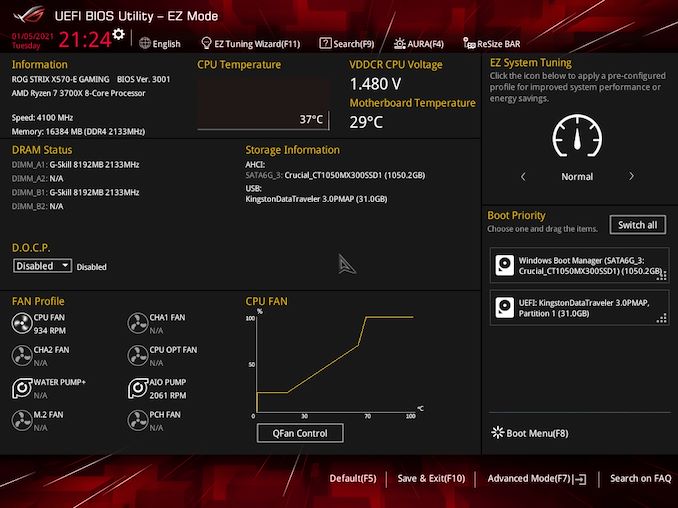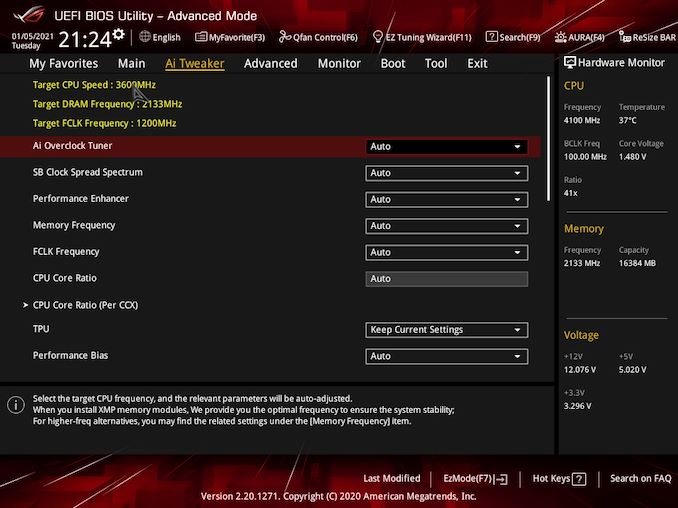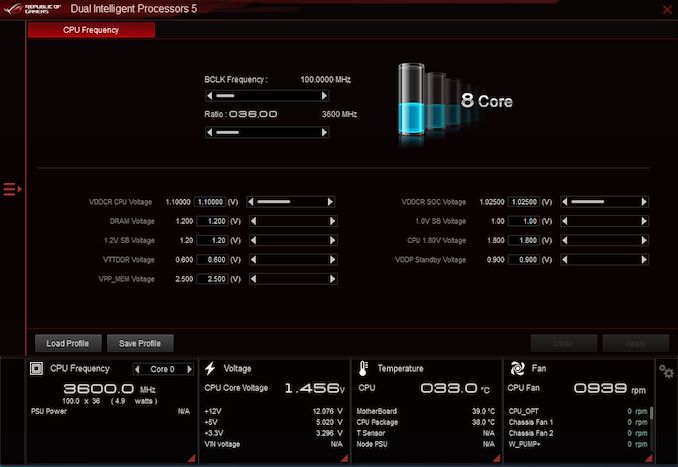The ASUS ROG Strix X570-E Gaming Motherboard Review
by Gavin Bonshor on January 25, 2021 11:00 AM EST- Posted in
- Motherboards
- AMD
- Asus
- ROG
- AM4
- Ryzen 3000
- X570
- Strix X570-E
- Ryzen 5000
- X570-E Gaming
BIOS
ASUS is using its Republic of Gamers firmware which has two primary modes with different levels of complexity: EZ and Advanced. The design of the BIOS is consistent throughout, with a ROG themed red, black and dark background, with contrasting grey and white text. This design used in both the EZ and Advanced modes which users can access by pressing the F7 key.
The basic 'EZ' mode is for novice users looking to make basic alterations. This includes basic XMP support (which ASUS calls DOCP on its AMD based models). On the basic screen is a list of core information including fan profile speeds, DRAM status, model and firmware version, current CPU Core voltage, and motherboard temperature. Users can use hotkeys to navigate between different sections of the firmware, as well as select the systems boot priority and access the QFan Control function integrated into the firmware.
Accessing the more intricate parts of the firmware, users will need to press F7 to switch to the Advanced mode. This area is where all of the board's primary settings are located and are divided into menus and submenus. The Ai Tweaker is where all of the overclocking settings are located and users can overclock the CPU, memory, and integrated graphics when used with a compatible Ryzen based APU.
It offers control for CPU frequency, Fabric Clock frequency (FLCK), which users can adjust to allow AMD's Infinity Fabric to operate in tandem with memory frequency. AMD recommends an FCLK of 1800 MHz when using DDR4-3600 memory which it says is the sweet spot for performance on the Ryzen platform. For quick and easy memory overclocking, users can enable D.O.C.P,.
Other notable elements of the firmware include its AURA section which allows users to customize the board's integrated RGB LEDs. The software offers much more in-depth control of this, but it's nice to see that AURA and the QFan utility make it into the firmware. As we've seen with previous ASUS ROG models over the last couple of years, its firmware is consistent, intuitive, and laid out very neatly.
Software
Some of the following analysis comes from our ASUS ROG Strix B550-F Gaming review as it shares the same software bundle as the ROG Strix X570-E Gaming.
One of the unique ASUS implementations to its Republic of Gamers branded motherboards is the Armory Crate, which is pooled into memory on the motherboard and contains basic networking drivers and all the software and utilities. Armory Crate pops up when Windows is first installed onto a system, so it looks like somehow ASUS has got into your install image. Not a fun thing if you don't know about it in advance.
Thankfully this is just some extra software that helps most users get hold of chipset and controller drivers as needed. It can be disabled in the BIOS if needed. Note this means that the Driver CD traditionally bundled with a motherboard isn't really needed, as long as you have an internet connection.
The ASUS AI Suite 3 utility is a combination of various software utilities that allow customization of power profiles, VRM power profiles, and load-line calibration settings. This also stretches to overclocking for the CPU, with options to adjust both CPU and BCLK frequency. Users can also make on the fly adjustments to voltages such as CPU VCore, memory voltage, and SoC voltages, although the firmware still offers the most for overclockers and enthusiasts. The AI Suite 3 software also allows access to its QFan tuning utility where users can customize fan profiles.
Other utilities in the ASUS package include the ROG Gamefirst VI network traffic shaping software, a custom skinned version of the CPU-Z monitoring utility, and its RAMCache III software. The ASUS Sonic Studio application also allows users to customize its auditory experience with effects and different sound profiles for things such as movies, music, and gaming. This includes frequency EQ customization too. As usual, the ASUS software package includes plenty of software to enhance user experience.


























46 Comments
View All Comments
du_bucha - Monday, January 25, 2021 - link
I have this board, they just forgot to tell that there is a bunch of bios upgrades in asus website that is causing a lot of errors in people systems, so it is a good thing check the asus forum first to see which ones are the stable bios before rushing into the last one ( using ver 3001 here but there is a 3402 beta already for download in asus website).Another thing that bothers me in this mb is the fact that it doesn't have a bios reset button for use when overclocking or fine tunning the memory. You only have an ancient jumper pin and terribly located in the bottom part of the motherboard.
The chipset sits right under the video card and suck all the hot air from it. My chipset temperatures was around 68ºC in idle with a GTX1060. Since I don't use the computer for gamming, I changed the GTX1060 to the second slot and changed the thermal pad too, and now chipset temp is around 62ºC.
These are the negative points I found in this board that was not mentioned in the review.
Beaver M. - Tuesday, January 26, 2021 - link
All new mainboards have issues with crappy firmware. But its starting to get ridiculous with X570 and B550 ones. They sure as hell arent new anymore. Only the Zen 3 CPUs are, and they have been released for a long time as well.Yet nothing seems to change or improve.
I am seriously rethinking of buying an AMD because of that and because of the WHEA issues (not to mention the still not fixed X570 IO issues.
Guess people (and me) were right still recommending Intel simply because they are far more stable.
Qasar - Tuesday, January 26, 2021 - link
news for you, myself, and some others i work with, have had issues with intel as well. be it bios updates or drivers. to claim intel is more stable, is also false.EG, i have 2 X99 boards, after a re install of win 10, for some reason, 6 of the 10 sata ports would not work after installing the latest drivers from the board maker AND intel's site, exclamation point in device manager. went back to both pages and tried a few of the driver revisions on both, i started to search for drivers. finally found ones that fixed the issue. this driver version was not available on either site.
i have this board, and it has been great for a year now. even with an issue with the SB Z sound card i have, and a bios update that cause it to reboot on its own from time to time, i would still get this board again. bottom line i have had issues with BOTH AMD AND Intel. and would get either or, depending in which has the performance and features i want for a price i am willing to pay. this round, its been amd, and have replaced 3 of 6 comps with amd and ryzen 3000 cpus that were intel.
Beaver M. - Tuesday, January 26, 2021 - link
So youre comparing ancient boards with new ones?Ok.
You know, my one Z170 board also has lots of issues. But they started over time, because........ its degrading after 5+ years.
The issues with AMD are filling reddit and other forums. Thats a fact. And its not issues that are because of rare hardware failures that are normal, its because of bugs in software AND hardware design that can be reproduced rather often. In comparison, when the first Skylake had the "768 FFT bug", or the Z87 bug, it wasnt nearly as huge of a problem as the AMD fanboys made it out to be. Plus they were fixed quickly.
The issues with AMD right now are vast, critical and numerous and some of them have been there for quite a long time (some even since Zen 2). And all you hear are crickets.
If Intel had those issues, the cries of havoc would be so shrill and loud that even your rose colored glasses would burst into tiny shards. And very justified so.
But this "users keeping silent/uncritical about serious issues" phenomenon has always been a part of AMD. Even 20 years ago. I fell for it several times myself.
Qasar - Tuesday, January 26, 2021 - link
yes, as while that issue with the sata ports were recent, when i picked up my x99 board new 5 years ago, i had issues then as well.the funny part, is EACH person has their own experience with either side. myself, i have had issues with BOTH. it hasnt been just amd, or just intel over the years.
" it wasnt nearly as huge of a problem as the AMD fanboys made it out to be " the SAME can be said about the intel fanboys with amd, whats your point ?
while you kind of accuse me of rose colored glasses, the same can be said for the other side as well, again whats your point ?
if intel does it, its just fine, and ok, but if AMD does it, its a federal offense.
Spunjji - Tuesday, January 26, 2021 - link
They managed to squeeze so much projection, prognostication and ventriloquism into a few tight little posts. It's an exceptional demonstration in partisan rhetoric married to denial.Qasar - Tuesday, January 26, 2021 - link
i didnt know that saying either side has had,and has, its issues was considered to be a demonstration in partisan rhetoric married to denial.Spunjji - Wednesday, January 27, 2021 - link
@Qasar - I was talking about Beaver M., not you. I agree entirely with you here. 👍Spunjji - Tuesday, January 26, 2021 - link
I'm impressed by the way you made a claim about forums, threw in the declarative "Thats a fact" (it wasn't, it's hyperbole) and then followed with another statement that *definitely* isn't a fact - it's clearly just your opinion. Very self-confident; Dunning and Kruger offer a salute.I also appreciated your completely un-self-aware commentary on how other people have "rose tinted glasses", even as you assume the truth of your casual dismissal of specific Intel issues. To make it extra funny from an outside perspective, you hype up a few other AMD issues you just didn't quite get around to specifically naming.
Whatever this bit you're doing is, it's very good!
Spunjji - Tuesday, January 26, 2021 - link
Cautiously-worded partisan FUD is still partisan FUD. You jumped from someone's specific anecdotal critique to a generalised one, then used that to bolster an unrelated conclusion.I Googled the WHEA issues, and it leads to two types of post:
1) People gathering data on the issue and noting that it doesn't do any harm in and of itself, and is often fairly trivially solved.
2) A bunch of similar posts on forums (some from the same users) that look like this: "My (fairly recent) high-spec Intel system was a saint that never crashed, and now my brand-new high-spec AMD system crashes aLl ThE tImE and this is definitely AMD's fault. /ragequit"
It's possible there's a selection bias here - and I might be missing a serious issue. I just don't really buy the way you introduced these topics.